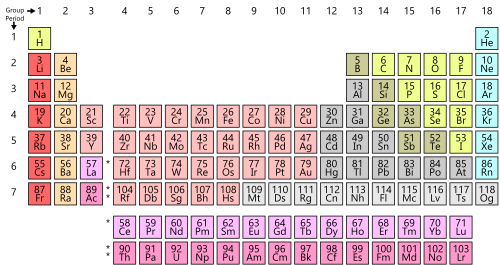The Elements (song)
"The Elements" is a song by musical humorist and lecturer Tom Lehrer, which recites the names of all the chemical elements known at the time of writing, up to number 102, nobelium. It was written in 1959 and can be found on his albums Tom Lehrer in Concert, More of Tom Lehrer and An Evening Wasted with Tom Lehrer. The song is sung to the tune of the "Major-General's Song" from The Pirates of Penzance by Gilbert and Sullivan.[1]

The song is also included in the musical revue Tom Foolery, along with many of Lehrer's other songs.
Description of the song
The ordering of elements in the lyrics fits the meter of the song, and includes much alliteration, and thus has little or no relation to the ordering in the periodic table. This can be seen for example in the opening and closing lines:
There's antimony, arsenic, aluminum, selenium,
And hydrogen and oxygen and nitrogen and rhenium,
... <!-- DON'T PUT THE WHOLE SONG HERE. SEE TALK PAGE. THANK YOU. -->
And argon, krypton, neon, radon, xenon, zinc, and rhodium,
And chlorine, carbon, cobalt, copper, tungsten, tin, and sodium.
These are the only ones of which the news has come to Harvard,
And there may be many others, but they haven't been discovered.
Lehrer was a Harvard Mathematics lecturer, and the final rhyme of "Harvard" and "discovered" is delivered in a parody of a Boston accent—a non-rhotic manner—so that the two words rhyme. Lehrer did not normally speak with that accent. Lehrer accompanied himself on the piano while singing the song.
Background
"The Elements" is sung to the tune of the "Major-General's Song" from The Pirates of Penzance by Gilbert and Sullivan.[1] Lehrer also drew the inspiration from the song "Tschaikowsky (and Other Russians)", written by Ira Gershwin, which listed fifty Russian composers in a similar manner.[2]
"The Elements" differs musically from the "Major-General's Song" in that:
- It omits the third verse of the original as well as all of the choral "responses", and adds an extra two lines at the end of the last verse.
- Lehrer simplifies the melody by primarily singing each phrase on a single note, instead of rapidly moving back and forth between two different notes as in Sullivan's original melody.
- It is in the key of C, while the "Major-General's Song" is in E-flat.
- On some of the live recordings, Lehrer pauses in the middle for spoken interludes, in which he talks to the audience (e.g., "I hope you're all taking notes, because there's going to be a short quiz next period!") while vamping on the piano.
- The song ends with a piano coda: "Shave and a Haircut".
In some live performances, after the song was finished, Lehrer told the audience of an earlier version, from Aristotle's time, that consists of Air, Fire, Water and Earth, explaining that "it was a much simpler time".
In popular culture
"The Elements" has been featured in popular culture many times. In the episode "Ex-File" of NCIS, Timothy McGee and Abby Sciuto hum the song, which forms a key clue in their case. In The Big Bang Theory episode "The Pants Alternative", a drunk Sheldon Cooper starts to sing the song during his acceptance of an award from his university. In the 2006 episode of Gilmore Girls called "The Real Paul Anka", Luke Danes's daughter April and her classmates sing the song on the bus.[3] Daniel Radcliffe sang "The Elements" on The Graham Norton Show in 2010.[4] The Jewish parody group Shlock Rock acknowledges Lehrer and "The Elements" as inspiration for "The Shabbat Song".[5] David Costabile, as Gale, sang along to the song in "Something Beautiful", a 2018 episode of Better Call Saul.[6]
Cover recordings include Jesse Dangerously on his album How to Express Your Dissenting Political Viewpoint Through Origami, where the song is titled "Tom Lehrer's The Elements".[7]
Footnotes
- Shepherd, Marc. "Tom Lehrer's 'The Elements' and 'Clementine' (1959)", The Gilbert and Sullivan Discography, 5 October 2008, accessed December 15, 2017
- "A Conversation With Tom Lehrer", BBC Interview, 1999.
- "IMDb Trivia: "Gilmore Girls" The Real Paul Anka (TV episode 2006)".
- "Daniel Radcliffe sings The Elements Song on The Graham Norton Show" on YouTube, broadcast November 12, 2010
- Liner notes for the CD "Woodshlock", ShlockRock.com
- Snierson, Dan. "Breaking Bad alum on his surprise Better Call Saul appearance – and whether he'll sing again", Entertainment Weekly, August 21, 2018
- "Tom Lehrer's The Elements" at Discogs.com
Further reading
- Too Many Songs by Tom Lehrer, 1981, has sheet music for many of Lehrer's songs, including The Elements.
External links
- Tom Lehrer's "The Elements" performed by Lehrer. Community Audio
- Lyrics and chords for the song
- Animation of the song on YouTube
- Another animation by Mike Stanfill
- Updated version through element 118, Oganesson